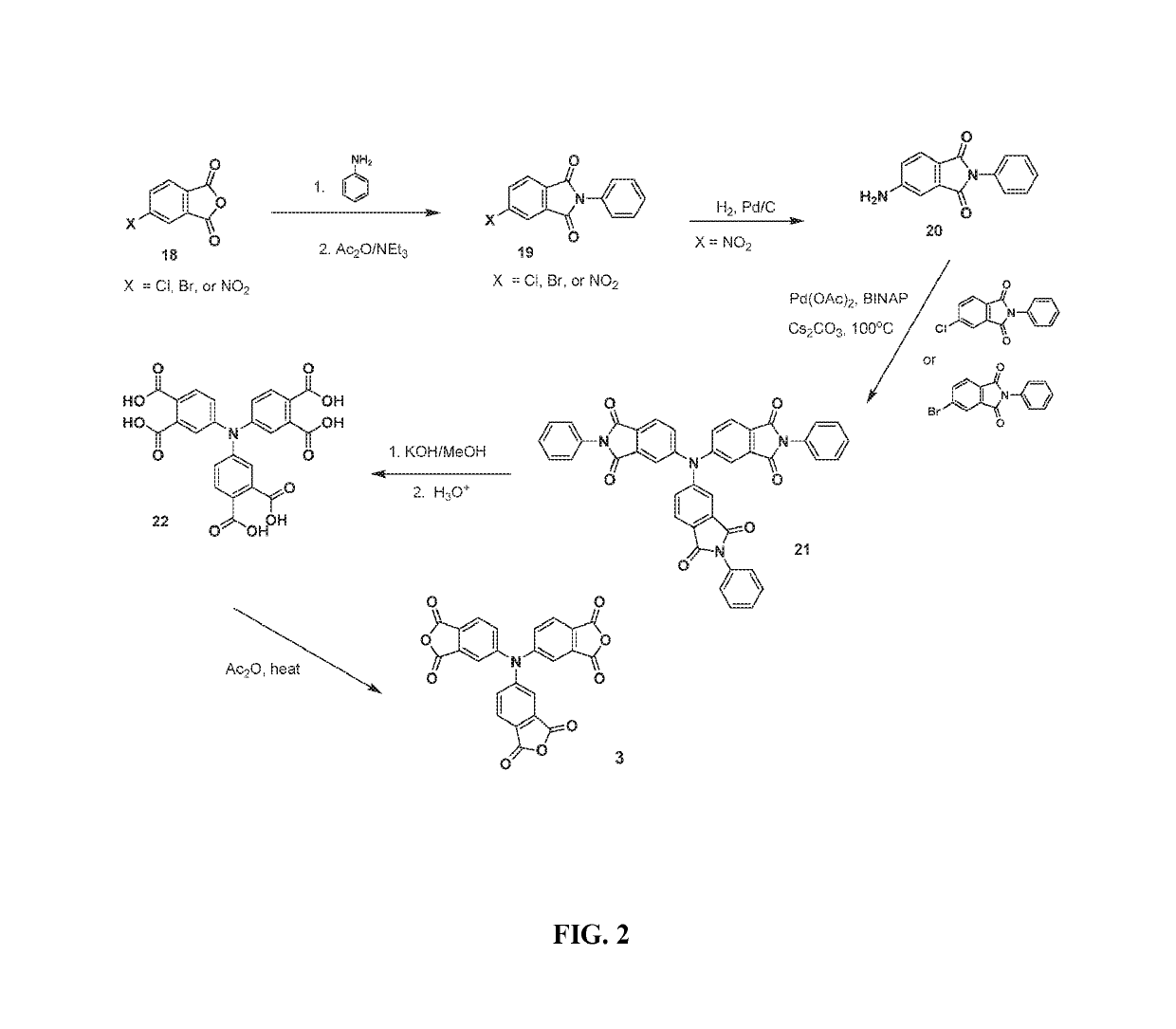Multifunctional crosslinking agent, crosslinked polymer, and method of making same
a crosslinking agent and multifunctional technology, applied in the field of multifunctional crosslinking agents and crosslinking polymers, can solve the problem of limited multifunctional amine crosslinking agents
- Summary
- Abstract
- Description
- Claims
- Application Information
AI Technical Summary
Benefits of technology
Problems solved by technology
Method used
Image
Examples
example 1
Tris(4-methoxyphenyl)phosphine Oxide (13a)
[0059]Into a 100 mL three-necked flask equipped with a magnetic stir bar and nitrogen inlet and outlet were placed commercially available tris(4-methoxyphenyl)phosphine ((12a), 3.0 g, 8.5 mmol) and acetone (30 mL). A mixture of water (2 mL) and H2O2 (35%, 1 mL, 9 mmol) was added slowly. After the mixture was stirred at room temperature for 1 h, acetone was evaporated and methylene chloride (50 mL) was added. The organic phase was washed with a saturated NaCl solution (35 mL) three times. The organic layer was dried over sodium sulfate. The solvent was removed under vacuum to afford 3.0 g (95%) of a white solid, m.p. 144.7-145.4° C. (lit. 143-144° C.). MS (m / e): 368 (M+). Anal. Calcd. for C21H21O4P: C, 68.47%; H, 5.75%; P, 8.41%. Found: C, 68.42%; H, 5.72%; P, 8.11%. FT-IR (KBr, cm−1): 3068, 3026, 2959, 2837, 1597, 1569, 1503, 1468, 1289, 1254, 1179, 1121, 1019, 803, 671, 543. 1H-NMR (CDCl3, 8 in ppm): 3.84 (s, 6H, CH3), 6.94-6.97 (dd, 6H, Ar...
example 2
Tris(4-hydroxyphenyl)phosphine Oxide (14a)
[0060]Into a 500 mL 3-neck round bottom flask equipped with stir bar, nitrogen inlet and condenser was charged tris(4-methoxyphenyl)phosphine oxide ((13a), 25.0 g, 67.9 mmol) followed by pyridine hydrochloride (250 g). The mixture was heated to 210° C. for 2 hours and allowed to cool to about 100° C. It was poured into water to afford 21.0 g (95.0%) of white crystals. m.p.: 274.8-276.8° C. (lit. 275-276° C.). The product was used without further purification. Anal. Calcd. for C18H15O4P: C, 66.26%; H, 4.63%; P, 9.49%; Found: C, 65.72%; H, 4.68%; P, 9.59%. 1H-NMR (DMSO-d6, δ in ppm): 6.84-6.86 (dd, 6H, Ar—H), 7.30-7.45 (dd, 6H, Ar—H), 10.07 (s, 3H, Ar—O—H). 13C-NMR (DMSO-d6, 8 in ppm): 115.32, 115.45, 122.59, 123.69, 133.29, 133.40, 160.28, 160.30.
example 3
Tris[4-(3,4-dicyanophenoxy)phenyl]phosphine Oxide (16a)
[0061]Into a 500 mL 3-neck round bottom flask equipped with stir bar, condenser, and nitrogen inlet were charged tris(4-hydroxyphenyl)phosphine oxide ((14a) 8.13 g, 25.0 mmol), 4-nitrophthalonitrile ((15), 13.0 g, 75.0 mmol), K2CO3 (11.5 g, 85.5 mmol), and DMF (150 mL). The mixture was heated at 50° C. for 24 h. Then it was poured into distilled water. The organic layer was extracted with ethyl acetate 3 times and dried over magnesium sulfate. The mixture was filtered and the filtrate was dried on a rotary evaporator afford 15.8 g (81%) of a yellow powder. m.p. 205.0-206.6° C. m.p. 127.6-132.8° C. The yellow powder was further purified by slurrying in ethyl acetate. m.p. 138.1-139.4° C. Anal. Calcd. for C42H21N6O4P: C, 71.59%; H, 3.00%; N, 11.93%. Found: C, 71.41%; H, 2.99%; N, 11.59%. 1H-NMR (DMSO-d6, δ in ppm): 7.33-7.35 (dd, 6H, Ar—H), 7.54-7.57 (dd, 3H, Ar—H), 7.73-7.78 (dd, 6H, Ar—H), 7.95-7.96 (d, 3H, Ar—H) 8.14-8.16 (d, 3...
PUM
| Property | Measurement | Unit |
|---|---|---|
| temperature | aaaaa | aaaaa |
| glass transition temperatures | aaaaa | aaaaa |
| temperature | aaaaa | aaaaa |
Abstract
Description
Claims
Application Information
 Login to View More
Login to View More - R&D
- Intellectual Property
- Life Sciences
- Materials
- Tech Scout
- Unparalleled Data Quality
- Higher Quality Content
- 60% Fewer Hallucinations
Browse by: Latest US Patents, China's latest patents, Technical Efficacy Thesaurus, Application Domain, Technology Topic, Popular Technical Reports.
© 2025 PatSnap. All rights reserved.Legal|Privacy policy|Modern Slavery Act Transparency Statement|Sitemap|About US| Contact US: help@patsnap.com



